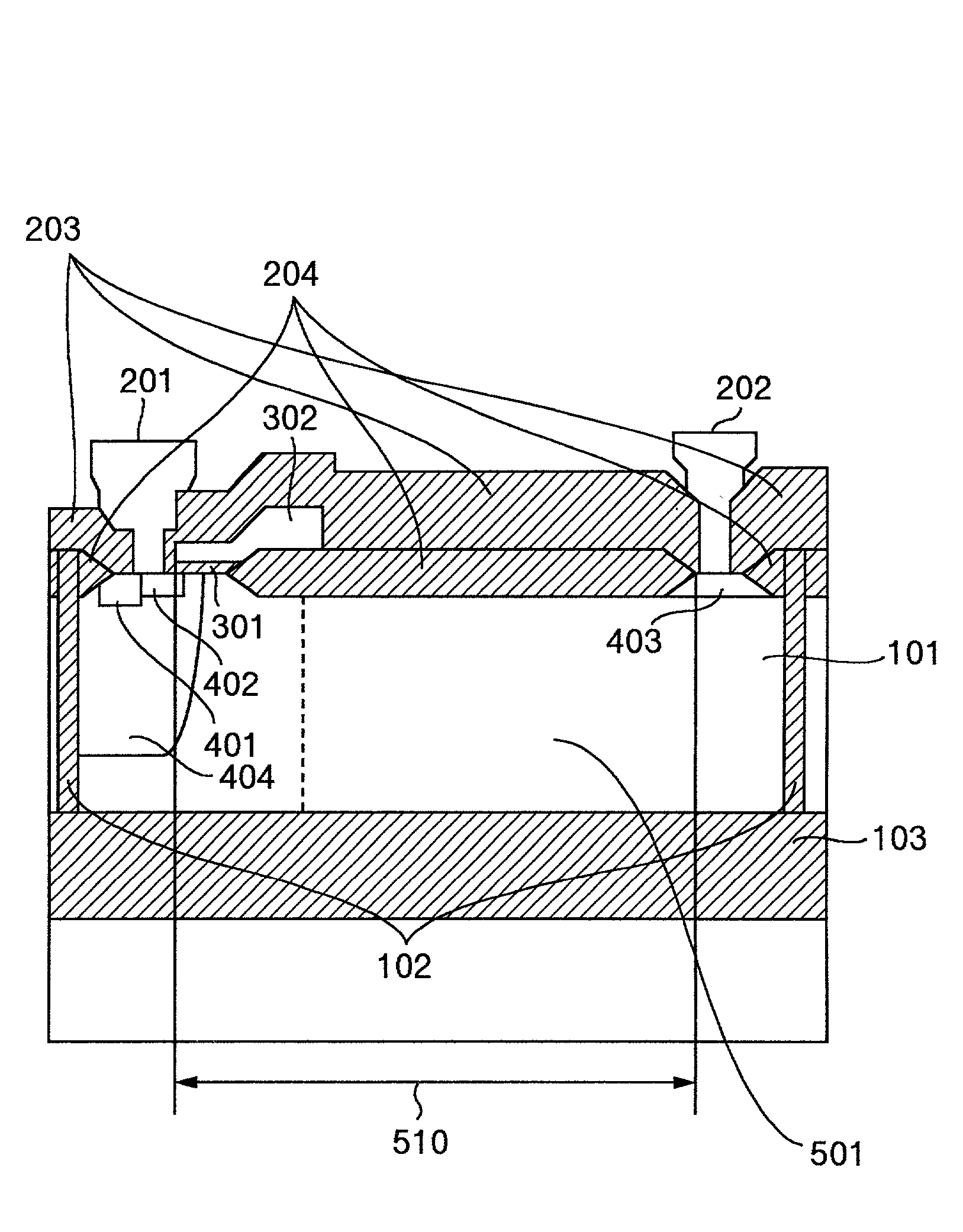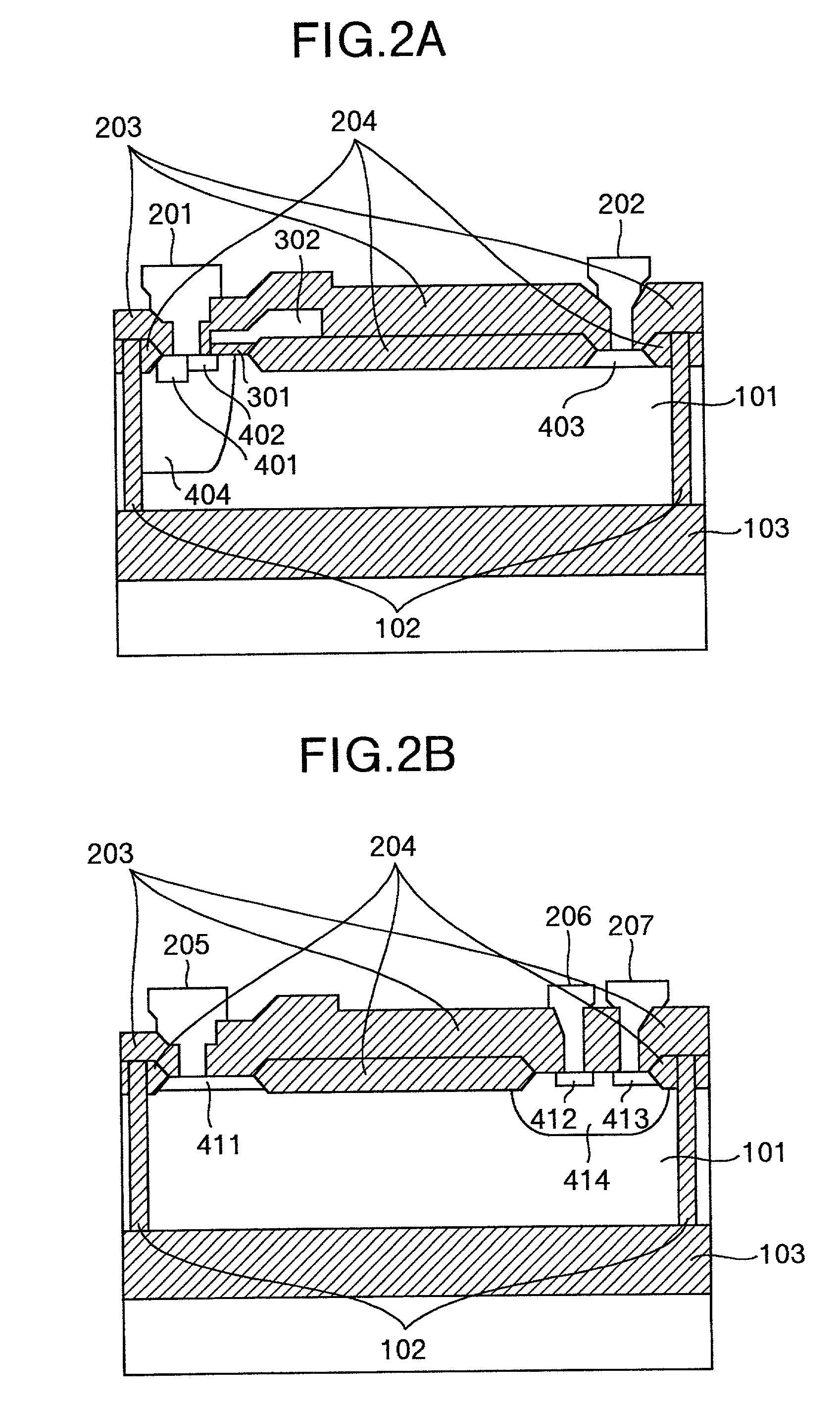Semiconductor device and manufactruing method therefor
- Summary
- Abstract
- Description
- Claims
- Application Information
AI Technical Summary
Benefits of technology
Problems solved by technology
Method used
Image
Examples
first embodiment
[0050] First, FIG. 1 shows a semiconductor device according to the present invention, and is a vertical sectional view illustrating the structure of an N-channel MOS field-effect transistor. The N-channel MOS field-effect transistor comprises the source electrode 201, and the drain electrode 202 and gate electrode 302 disposed in a lateral direction via the field oxide film 204, on the SOI substrate 101 having the N-type device-forming region. The transistor further comprises the gate oxide film 301, high concentration P-type layer 401, high concentration N-type layer 402, high concentration N-type layer 403, and p-type layer or p-body layer 404. The gate oxide film 301 is in contact with the gate electrode 302. The high concentration P-type layer 401 is in contact with the source electrode 201, and the high concentration N-type layer 402 is in contact with the source electrode 201 and the gate oxide film 301. The high concentration N-type layer 403 is in contact with the drain elec...
second embodiment
[0052] FIG. 4 shows a semiconductor device according to the present invention, and is a vertical sectional view illustrating the structure of an NPN bipolar transistor. The NPN bipolar transistor comprises the collector electrode 205, and the base electrode 206 and the emitter electrode 207 disposed in the lateral direction via the field oxide film 204, on the SOI substrate 101 having the N-type device-forming region. The transistor further comprises the high concentration N-type layer 411, high concentration P-type layer 412, high concentration N-type layer 413, and p-type base layer 414. The high concentration N-type layer 411 is in contact with the collector electrode 205. The high concentration P-type layer 412 is in contact with the base electrode 206. The high concentration N-type layer 413 is in contact with the emitter electrode 207. The P-type base layer 414 is in contact with the high concentration p-type layer 412 and the high concentration N-type layer 413. This transist...
third embodiment
[0054] FIG. 5 shows a semiconductor device according to the present invention, and is a vertical sectional view illustrating an N-channel MOS field-effect transistor. The N-channel MOS field-effect transistor comprises the source electrode 201, and the drain electrode 202 and the gate electrode 302 disposed in the lateral direction via the field oxide film 204, on the SOI substrate having the N-type device-forming region. The transistor further comprises the gate oxide film 301 in contact with the gate electrode 302, high concentration P-type layer 401, high concentration N-type layer 402, high concentration N-type layer 403, and p-type layer or p-body layer 404. The high concentration P-type layer 401 is in contact with the source electrode 201. The high concentration N-type layer 402 is in contact with the source electrode 201 and the gate oxide film 301. The high concentration N-type layer 403 is in contact with the drain electrode 202. The p-body layer 404 is in contact with the...
PUM
 Login to View More
Login to View More Abstract
Description
Claims
Application Information
 Login to View More
Login to View More - R&D
- Intellectual Property
- Life Sciences
- Materials
- Tech Scout
- Unparalleled Data Quality
- Higher Quality Content
- 60% Fewer Hallucinations
Browse by: Latest US Patents, China's latest patents, Technical Efficacy Thesaurus, Application Domain, Technology Topic, Popular Technical Reports.
© 2025 PatSnap. All rights reserved.Legal|Privacy policy|Modern Slavery Act Transparency Statement|Sitemap|About US| Contact US: help@patsnap.com



